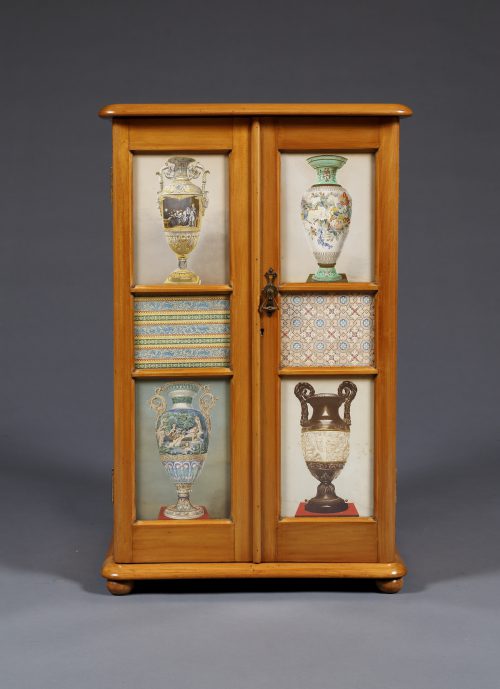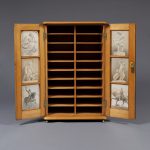11133b AN UNUSUAL WALNUT SIDE CABINET MOUNTED WITH ILLUSTRATIONS OF GREAT EXHIBITION OBJECTS BY J.B. WARING, AND POSSIBLY MADE FOR THE LITHOGRAPHY OFFICES OF DAY & SON, LTD. English. Circa 1863. Measurements: Height: 34 1/4” (87 cm) Width: 22” (56 cm) Depth: 16 1/3” (41. 5 cm).

Research
Of maple. The cabinet with two doors containing a total of twelve color lithographs, behind glass panes, and raised on brass casters. The interiors fitted with two side by side drawers at the top above four shelves.
This interesting side cabinet has been decorated with colorful lithographs of various decorative art objects, contained behind panes of glass on both the exterior and interior doors. The panels on the front of each cabinet door are taken from J. B. Waring’s “Masterpieces of Industrial Art and Sculpture at the [London] International Exhibition, 1862” (Day & Son, 1863), a three-volume set comprising 300 color plates. The selected illustrations include porcelain vases and plates, mainly by royal manufactories of Meissen, Copenhagen, Berlin, St. Petersburg and Paris, and from English potteries, as well as Viennese cloth and paper hangings. The grisaille plates of sculptures in the interior of the cabinet come from Matthew Digby Wyatt’s “Industrial Arts of the Nineteenth Century. A series of illustrations of the choicest specimens produced by every nation, at the Great Exhibition of Works of Industry, 1851” (Day & Son, 1851-53).
Sir Matthew Digby Wyatt (1820-1877) was a British art historian and architect who began in the office of his brother, Thomas Henry Wyatt. Over the course of his career he served in such important cultural positions as Secretary of the Great Exhibition of 1851, Slade Professor of Fine art at Cambridge, Honorary Secretary of the Royal Institute for British Architects, and Surveyor of the East India Company. As an architect Wyatt was responsible for “restorations of buildings and memorial monuments and royal and government commissions.”1 He worked on the the decoration of the Crystal Palace at Sydenham in 1854 and published works on art theory and practice. Wyatt exhibited drawings at the 1851 exhibition and reported on the fair, in addition to producing the two-volume “Industrial Arts of the Nineteenth Century,” which highlighted pieces of exceptional merit.
Like his contemporary, John Burley Waring (1823-1875) was an English architect and artist who, in his early years, studied in London, Italy, Spain and Paris, where he refined his skills as a draughtsman and produced works such as “Designs for Civic Architecture” (circa 1850) and “The Arts Connected with Architecture in Central Italy” (1858). Waring was involved with a number of the 19th century world’s fairs. He produced four guide books to the courts of the Crystal Palace for the Great Exhibition of 1851 in conjunction with Sir Matthew Digby Wyatt, and served as superintendent of the works of ornamental art and sculpture in the Manchester Exhibition in 1857. In 1862 he was appointed superintendent of the architectural gallery and of the classes for furniture, earthenware, and glass, goldsmiths’ work and jewellery, and objects used in architecture at the International Exhibition, for which he published the aforementioned “Masterpieces of Industrial Art and Sculpture…”
Both Waring and Wyatt’s volumes were published by Day & Son, lithographers to the Queen and one of the most prominent lithographic firms of the mid-19th century. The firm was founded in 1823 by William Day, and on his death in 1845 was left to his son of the same name. They held the unique position in Britain of both printmaking and publishing books, many of which contained their own plates. Day & Son’s chromo-lithograhy display won a prize medal in the Fine Arts Court at the Great Exhibition of 1851, and they exhibited at the 1862 exhibition as well, where the firm was praised for displaying “the finest work ever produced in this style…The printing of these works is equally perfect, the register of the colours is true to a hair’s-breadth, and the colours themselves clear and right, as if painted by hand.”2 Wyatt himself said that he “used the best means of graphic representation available” when publishing “Industrial Arts of the Nineteenth Century.”3 In addition to Wyatt and Waring, Day & Son also collaborated with renowned architect and designer Owen Jones, and printed his seminal work “The Grammar of Ornament” in 1856.
On inspection of both the lithographs in the published volumes and those on the cabinet doors, it is clear that they have been produced from the same plates. It is possible, therefore, that the cabinet originally belonged to the offices of Day & Son, as they were so closely associated with both Waring and Wyatt’s projects, and the Great Exhibitions, allowing a practical piece of office furniture to also serve as an aesthetic tribute to the company’s graphic output.
Footnotes
1. “Sir Matthew Digby Wyatt.” Dictionary of Art Historians. Department of Art, Art History and Visual Studies, Duke University, n.d. Web. 27 May 2015. <https://dictionaryofarthistorians.org/wyattm.htm>.
2. The Record of the International Exhibition, 1862. Glasgow: William Mackenzie, 1862. 454.
3. M. Digby Wyatt, Industrial Arts of the Nineteenth Century, 2 vols., Day & Son, 1851-3, vol. 1, p. v.



Comments are closed.